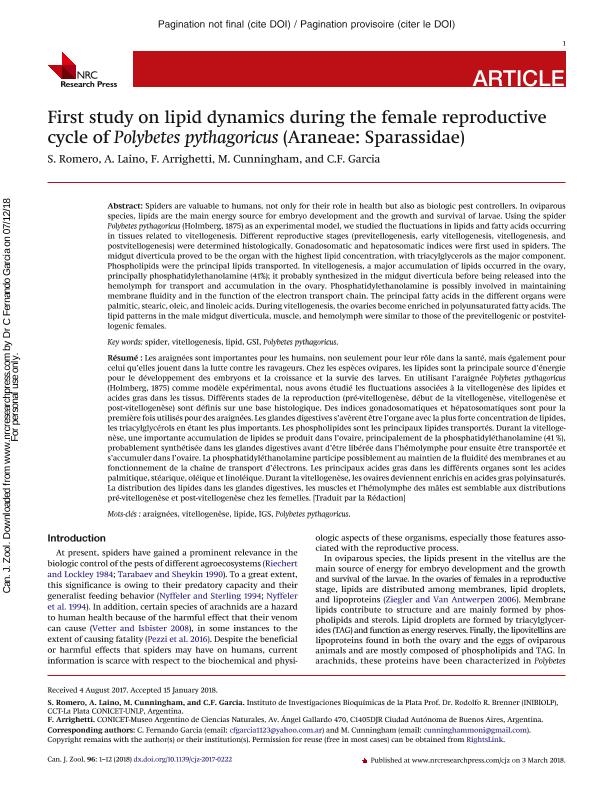Artículo
Spiders are valuable to humans, not only for their role in health but also as biologic pest controllers. In oviparous species, lipids are the main energy source for embryo development and the growth and survival of larvae. Using the spider Polybetes pythagoricus (Holmberg, 1875) as an experimental model, we studied the fluctuations in lipids and fatty acids occurring in tissues related to vitellogenesis. Different reproductive stages (previtellogenesis, early vitellogenesis, vitellogenesis, and postvitellogenesis) were determined histologically. Gonadosomatic and hepatosomatic indices were first used in spiders. The midgut diverticula proved to be the organ with the highest lipid concentration, with triacylglycerols as the major component. Phospholipids were the principal lipids transported. In vitellogenesis, a major accumulation of lipids occurred in the ovary, principally phosphatidylethanolamine (41%); it probably synthesized in the midgut diverticula before being released into the hemolymph for transport and accumulation in the ovary. Phosphatidylethanolamine is possibly involved in maintaining membrane fluidity and in the function of the electron transport chain. The principal fatty acids in the different organs were palmitic, stearic, oleic, and linoleic acids. During vitellogenesis, the ovaries become enriched in polyunsaturated fatty acids. The lipid patterns in the male midgut diverticula, muscle, and hemolymph were similar to those of the previtellogenic or postvitellogenic females. Les araignées sont importantes pour les humains, non seulement pour leur rôle dans la santé, mais également pour celui qu’elles jouent dans la lutte contre les ravageurs. Chez les espèces ovipares, les lipides sont la principale source d’énergie pour le développement des embryons et la croissance et la survie des larves. En utilisant l’araignée Polybetes pythagoricus (Holmberg, 1875) comme modèle expérimental, nous avons étudié les fluctuations associées à la vitellogenèse des lipides et acides gras dans les tissus. Différents stades de la reproduction (pré-vitellogenèse, début de la vitellogenèse, vitellogenèse et post-vitellogenèse) sont définis sur une base histologique. Des indices gonadosomatiques et hépatosomatiques sont pour la première fois utilisés pour des araignées. Les glandes digestives s’avèrent être l’organe avec la plus forte concentration de lipides, les triacylglycérols en étant les plus importants. Les phospholipides sont les principaux lipides transportés. Durant la vitellogenèse, une importante accumulation de lipides se produit dans l’ovaire, principalement de la phosphatidyléthanolamine (41 %), probablement synthétisée dans les glandes digestives avant d’être libérée dans l’hémolymphe pour ensuite être transportée et s’accumuler dans l’ovaire. La phosphatidyléthanolamine participe possiblement au maintien de la fluidité des membranes et au fonctionnement de la chaîne de transport d’électrons. Les principaux acides gras dans les différents organes sont les acides palmitique, stéarique, oléique et linoléique. Durant la vitellogenèse, les ovaires deviennent enrichis en acides gras polyinsaturés. La distribution des lipides dans les glandes digestives, les muscles et l’hémolymphe des mâles est semblable aux distributions pré-vitellogenèse et post-vitellogenèse chez les femelles
First study on lipid dynamics during the female reproductive cycle of polybetes pythagoricus (Araneae: Sparassidae)
Romero, Sofía Micaela ; Laino Sanchís, Fabricio Andrés
; Laino Sanchís, Fabricio Andrés ; Arrighetti, Florencia
; Arrighetti, Florencia ; Cunningham, Monica Liliana
; Cunningham, Monica Liliana ; Garcia, Carlos Fernando
; Garcia, Carlos Fernando
 ; Laino Sanchís, Fabricio Andrés
; Laino Sanchís, Fabricio Andrés ; Arrighetti, Florencia
; Arrighetti, Florencia ; Cunningham, Monica Liliana
; Cunningham, Monica Liliana ; Garcia, Carlos Fernando
; Garcia, Carlos Fernando
Fecha de publicación:
01/2018
Editorial:
National Research Council Canada-NRC Research Press
Revista:
Canadian Journal of Zoology
ISSN:
0008-4301
Idioma:
Inglés
Tipo de recurso:
Artículo publicado
Clasificación temática:
Resumen
Palabras clave:
GSI
,
LIPID
,
POLYBETES PYTHAGORICUS
,
SPIDER
,
VITELLOGENESIS
Archivos asociados
Licencia
Identificadores
Colecciones
Articulos(INIBIOLP)
Articulos de INST.DE INVEST.BIOQUIMICAS DE LA PLATA
Articulos de INST.DE INVEST.BIOQUIMICAS DE LA PLATA
Citación
Romero, Sofía Micaela; Laino Sanchís, Fabricio Andrés; Arrighetti, Florencia; Cunningham, Monica Liliana; Garcia, Carlos Fernando; First study on lipid dynamics during the female reproductive cycle of polybetes pythagoricus (Araneae: Sparassidae); National Research Council Canada-NRC Research Press; Canadian Journal of Zoology; 96; 8; 1-2018; 847-858
Compartir
Altmétricas



